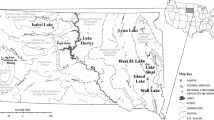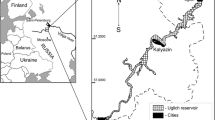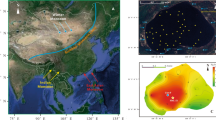Abstract—
The paper presents data on the features of Hg distribution and its input in dated bottom sediments in two Arctic lakes: Longtibeito on the Yamal Peninsula and Gol’tsovoe on the Gydan Peninsula. The Hg concentrations are much higher in the upper layers of the sediments, and the enrichment factors are 14 and 10 at background concentrations of 4.3 and 5.2 ng g–1, respectively. The sedimentation rates in both lakes are fairly high: the rate for Longtibeito Lake varied relatively little and is 660 ± 75 g m–2 year–1 on average, and that for Gol’tsovoe Lake decreased toward upper layers from 791 to 513 g m–2 year–1. The fluxes of total Hg in these lakes are principally different, but their lithogenic fluxes are approximately equal: 5–7 μg m–2 year–1. Mercury flux into Longtibeito Lake is much higher than into Gol’tsovoe Lake and amounts to 41.5 μg m–2 year–1. Layer-by-layer grain-size analysis with determination of Hg in each fraction, highlights differences between the lakes. The total Hg concentration in a layer in Gol’tsovoe Lake is controlled by the fine fraction (<0.045 mm), whereas this fraction in Longtibeito Lake dominates because of the high mass percentage. It has been shown that bottom sediments contain large (>0.2 mm) particles with high Hg concentrations. One of the likely reasons for the increase in Hg concentration in the upper layers may have been the development of oil and gas fields in this territory.


Similar content being viewed by others
REFERENCES
S. M. Allen-Gil, J. Ford, B. K. Lasorsa, M. Monetti, T. Vlasova, and D. H. Landers, “Heavy metal contamination in the Taimyr Peninsula, Siberian Arctic,” Sci. Tot. Environ. 301, 119–138 (2003).
AMAP. AMAP Assessment 2011: Mercury in the Arctic. Oslo, Norway: Arctic Monitoring and Assessment Programme (AMAP, 2011).
Atlas of the Yamal-Nenets Autonomous Okrug (Omsk. Kaertograf. Fabrika, Omsk, 2004) [in Russian].
L. Bengtsson, V. A. Semenov, and O. M. Johannessen, “The early twentieth-century warming in the Arctic–a possible mechanism,” J. Climate. 17 (20), 4045–4057 (2004).
H. Biester, R. Bindler, A. Martinez-Cortizas, and D. R. Engstrom, “Modeling the past atmospheric deposition of mercury using natural archives,” Environ. Sci. Technol. 41, 4852–4860 (2007).
S. M. Burke, C. E. Zimmerman, B. A. Branfireun, J. C. Koch, and H. K. Swanson, “Patterns and controls of mercury accumulation in sediments from three thermokarst lakes on the Arctic Coastal Plain of Alaska,” Aquatic Sci. 80, 1 (2018). https://doi.org/10.1007/s00027-017-0553-0
V. A. Dauvalter and N. A. Kashulin, “Assessment of the ecological state of the Arctic freshwater system based on concentrations of heavy metals in the bottom sediments,” Geochem. Int. 56 (8), 842–856 (2018).
V. A. Dauvalter, N. A. Kashulin, and D. B. Denisov, “Heavy metal variations in bottom sediments of the North Fennoscandian lakes in recent centuries,” Tr. Karel’sk. Nauchn. Ts. RAN, No. 9, 62–75 (2015).
P. E. Drevnick, C. Cooke, D. Barraza, J. Blais, K. Coale, B. Cumming, et al., “Spatiotemporal patterns of mercury accumulation in lake sediments of western North America,” Sci. Total Environ. 568, 1157–1170 (2016).
W. F. Fitzgerald, D. R. Engstrom, C. H. Lamborg, C.‑M. Tseng, P. H. Balcom, and C. R. Hammerschmidt, “Modern and historic atmospheric mercury fluxes in northern Alaska: Global sources and Arctic depletion,” Environ. Sci. Technol. 39, 557–568 (2005).
U. Förstner and W. Salomons, “Trace metal analysis on polluted sediments. Part I: Assessment of sources and intensities,” Environ. Technol. Lett. 1, 494–505 (1980).
M. E. Goodsite, P. M. Outridge, J. H. Christensen, A. Dastoor, D. Muir, O. Travnikov, and S. Wilson, “How well do environmental archives of atmospheric mercury deposition in the Arctic reproduce rates and trends depicted by atmospheric models and measurements?,” Sci. Tot. Environ. 452–453, 196–207 (2013).
A. J. Groot de, K. H. Zschuppe, and W. Salomons, “Standardization of methods of analysis for heavy metals in sediments,” Hydrobiologia 92, 689–695 (1982).
M. H. Hermanson, “Anthropogenic mercury deposition to Arctic lake sediments,” Water Air Soil Pollut. 101, 309–321 (1998).
K. Johansson, “Mercury in sediment in Swedish forest lakes,” Verh. Int. Ver. Theor. Angew. Limnol. 22, 2359–2363 (1985).
J. Kirk and A. Gleason, “Tracking long-range atmospheric transport of contaminants in Arctic regions using lake sediments,” In: Environmental Contaminants. Developments in Paleoenvironmental Research, Ed. by J. Blais, M. Rosen, and J. Smol (Springer, Dordrecht. 2015), Vol. 18, pp. 223–262. https://doi.org/10.1007/978-94-017-9541-8_10
D. Landers, C. Gubala, M. Verta, M. Lucotte, K. Johansson, T. Vlasova, and W. L. Lockhart, “Using lake sediment mercury flux ratios to evaluate the regional and continental dimensions of mercury deposition in Arctic and boreal ecosystems,” Atmos. Environ. 32 (5), 919–928 (1998).
O. Lindqvist, K. Johansson, M. Aastrup, A. Andcrsson, L. Bringmark, G. Hovsenius, L. Hakanson, A. Iverfeldt, M. Meili, and B. Timm, “Mercury in the Swedish environment—Recent research on causes, consequences and corrective methods,” Water Air Soil Pollut. 55 (1–2), 1–261 (1991).
W. L. Lockhart, P. Wilkinson, B. N. Billeck, R. A. Danell, R. V. Hunt, G. J. Brunskill, J. Delaronde, and V. St. Louis, “Fluxes of mercury to lake sediments in central and northern Canada inferred from dated sediment cores,” Biogeochemistry 40, 163–173 (1998).
W. L. Lockhart, R. W. Macdonald, P. M. Outridge, P. Wilkinson, J. B. DeLaronde, and J. W. M. Rudd, “Tests of the fidelity of lake sediment core records of mercury deposition to known histories of mercury contamination,” Sci. Total Environ. 260, 171–180 (2000).
T. I. Moiseenko and L. V. Razumovsky, “Reconstruction of environmental changes in Western Siberia: evidence from the diatom complexes of lake sediments,” Dokl. Earth Sci. 487 (1), 810–814 (2019).
D. V. Moskovchenko and A. G. Babushkin, Formation of the chemical composition of snow waters at the territory of the Khanty–Mansi autonomous okrug,” Kriosf. Zemli 16 (1), 71–81 (2012).
D. Muir, X. Wang, F. Yang, N. Nguyen, T. Jackson, M. Evans, M. Douglas, and G. Kӧck, “Spatial trends and historical deposition of mercury in eastern and northern Canada inferred from lake sediment cores,” Environ. Sci. Technol. 43, 4802–4809 (2009).
E. A. Nater and D. F. Grigal, “Regional trends in mercury distribution across the Great Lakes states, north central USA,” Nature 358, 139–141 (1992).
National Atmospheric Deposition Network (NADP) (2004). http://nadp.sws.uiuc.edu/mdn/
S. Norton and J. Kahl, “A comparison of lake sediments and ombrotrophic peat deposits as long-term monitors of atmospheric pollution,” in New Approaches to Monitoring Aquatic Ecosystems, Ed. by T. Boyle (ASTM International, West Conshohocken, 1987), pp. 40–57.
D. Obrist, Y. Agnan, M. Jiskra, C. L. Olson, D. P. Colegrove, J. Hueber, C. W. Moore, J. E. Sonke, and D. Helmig, “Tundra uptake of atmospheric elemental mercury drives Arctic mercury pollution,” Nature 547 (7662), 201 (2017). https://doi.org/10.1038/nature22997
P. Outridge, G. Stern, P. Hamilton, J. Percival, R. McNeely, and W. Lockhart, “Trace metal profiles in the varved sediment of an Arctic lake,” Geochim. Cosmochim. Acta 69, 4881–4894 (2005).
P. M. Outridge, N. Rausch, J. B. Percival, W. Shotyk, and R. McNeely, “Comparison of mercury and zinc profiles in peat and lake sediment archives with historical changes in emissions from the Flin Flon metal smelter, Manitoba, Canada,” Sci. Total Environ. 409, 548–563 (2011).
E. Perry, S. A. Norton, N. C. Kamman, P. M. Lorey, and C. T. Driscoll, “Deconstruction of Historic Mercury Accumulation in Lake Sediments, Northeastern United States,” Ecotoxicology. 14, 85–99 (2005).
C. Reimann and P. de Caritat, “Distinguishing between natural and anthropogenic sources for elements in the environment: regional geochemical surveys versus enrichment factors,” Sci. Tot. Environ. 337, 91–107 (2005).
S. Rognerud, T. Skotvold, E. Fjeld, S. A. Norton, and A. Hobæk, “Concentrations of trace elements in recent and preindustrial sediments from Norwegian and Russian Arctic lakes,” Can. J. Fish. Aquat. Sci. 55, 1512–1523 (1998).
J. Rydberg, V. Gälman, I. Renberg, L. Lambertsson, A. Martínez-Cortizas, and R. Bindler, “Assessing the stability of mercury and methylmercury in a Varved Lake sediment deposit,” Environ. Sci. Technol. 42 (12), 4391–4396 (2008).
H. Sanei, P. M. Outridge, A. Dallimore, and P. B. Hamilton, “Mercury-organic matter relationships in the pre-pollution sediments of thermokast and tundra lakes from the Mackenzie River Delta,” Biogeochemistry 107, 149–164 (2012).
E. B. Swain, D. R. Engstrom, M. E. Brigham, T. A. Henning, and P. L. Brczonik, “Increasing rates of atmospheric mercury deposition in Midcontinental North America,” Science 257, 784–787 (1992).
Yu. G. Tatsii and Yu. I. Stakheev, Determination of mercury content in samples of complex composition,” Partnery Konkurenty, No. 4, 29–34 (2001).
Yu. G. Tatsii, T. I. Moiseenko, L. V. Razumovskii, A. P. Borisov, V. Yu. Khoroshavin, and D. Yu. Baranov, “Bottom sediments of the West Siberian Arctic lakes as indicators of environmental changes,” Geochem. Int. 58(4), 408–422 (2020).
Funding
This study was carried out under government-financed research project 0137-2019-0008 for Vernadsky Institute of Geochemistry and Analytical Chemistry, Russian Academy of Sciences, and was financially supported by the Russian Foundation for Basic Research, project no. 18-05-60012.
Author information
Authors and Affiliations
Corresponding authors
Additional information
Translated by E. Kurdyukov
Rights and permissions
About this article
Cite this article
Tatsii, Y.G., Baranov, D.Y. Features of Mercury Accumulation in the Bottom Sediments of Two Arctic Lakes in West Siberia. Geochem. Int. 60, 213–221 (2022). https://doi.org/10.1134/S0016702922020094
Received:
Revised:
Accepted:
Published:
Issue Date:
DOI: https://doi.org/10.1134/S0016702922020094




